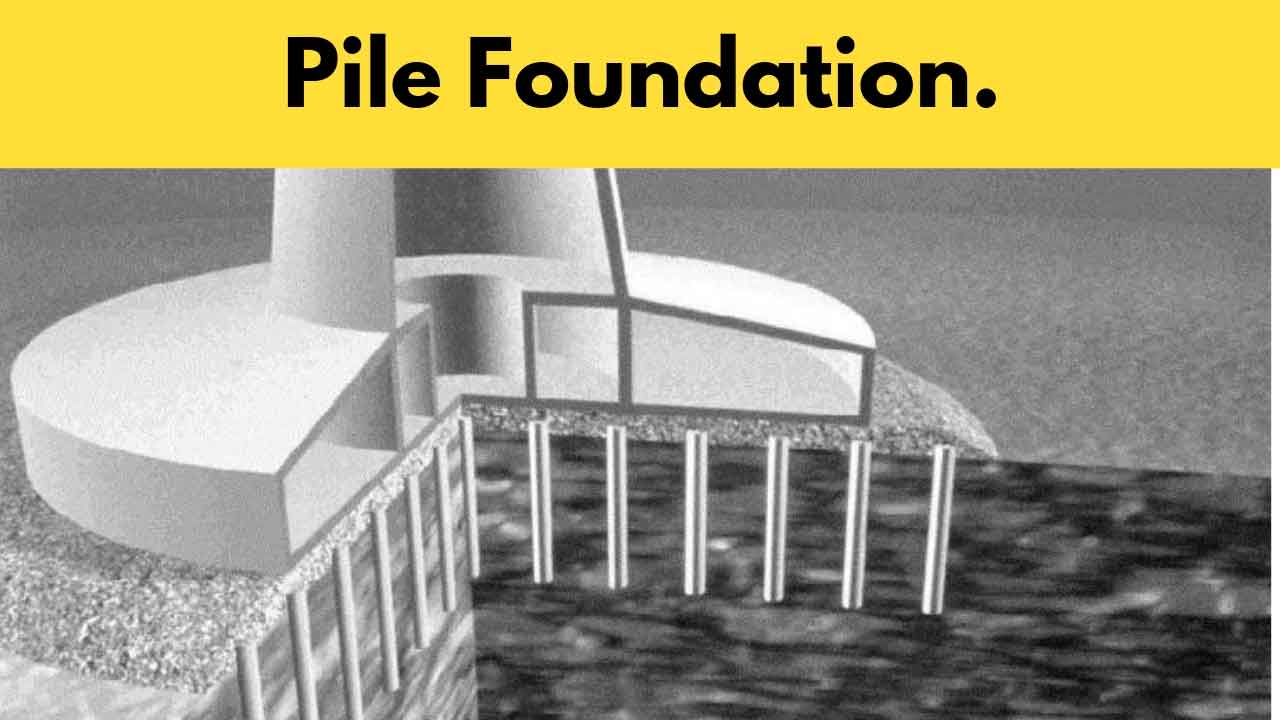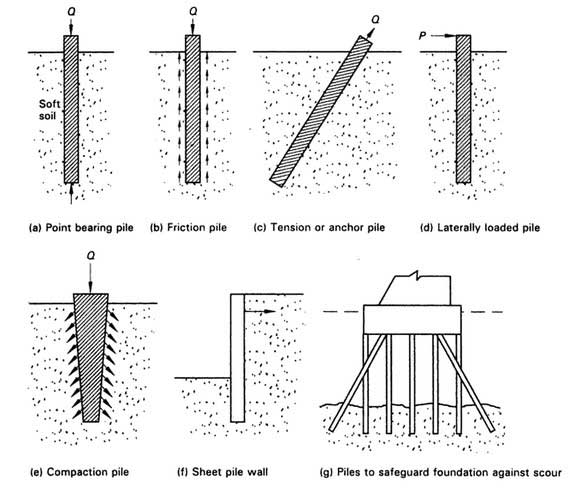So, Let’s Start.
What is Pile Foundation?
Pile foundations are employed when the soil strata immediately beneath the structure are not capable of supporting the load with the tolerable settlement or adequate safety against shear failure.
Pile foundation is a one form of a deep foundation.
Piles are relatively long, slender members that are driven into the ground or cast-in-situ.
Piles have been used from pre-historic times.
Today pile foundation is more common than any other type of deep foundation, especially where the soil conditions are unfavorable for the use of shallow foundations.
Types of Pile Foundation.
Piles may be classified in a number of ways based on different criteria:
1. function or action,
2. composition and material, and
3. installation.
1. Classification of Pile Based on Function or action.
The following classification is based on function or action.
(i). End-Bearing Piles.
In End Bearing Piles, the load is transferred through the pile tip to a suitable bearing stratum.
(ii). Friction Piles.
In Friction Piles, the load is transferred through a depth by skin friction along the surface area of the pile.
(iv). Tension or Uplift Piles.
This type of pile foundation is used to anchor structures subjected to uplift due to hydrostatic pressure or overturning moment due to horizontal forces.
(v). Compaction Piles.
Compaction Piles are used to compact loose granular soils in order to increase the bearing capacity of soil; a sand pile is used to form this type of pile as it doesn’t need to carry any load.
(vi). Anchor Piles.
These Piles are used to provide anchorage against the horizontal pull.
(vii). Fender Piles.
This type of pile is used to protect waterfront structures against impact from ships or other floating objects.
(viii). Sheet piles.
Sheet Piles are commonly used as bulkheads or cut-off to reduce seepage and uplift in hydraulic structures.
(ix). Batter Piles.
Batter Pile is used to resist horizontal and inclined forces, especially in waterfront structures.
(x). Laterally Loaded Piles.
These types of piles are used to support retaining walls, bridges and dams, and as fenders in docks and harbors.
2. Types of Pile Base on Composition and Material.
Piles can also be classified based on material and composition as follows.
(i). Timber Piles.
Timber of sound quality is used.
Timber piles perform well in either fully dry condition or submerged condition.
(ii). Steel Piles.
These are usually H-piles, pipe piles, or sheet piles (rolled sections of regular shapes).
(iii). Concrete Piles.
These may be precast or cast-in-situ.
Precast piles are invariably reinforced.
Cast-in-situ piles are installed by pre-excavation; the common types are Raymond pile, MacArthur pile, and Franki pile.
(iv). Composite Piles.
These are made of either concrete and timber or concrete and steel.
They are used when part of the pile is submerged under water.
3. Types of Pile Based on Installation.
Piles can also be classified based on the method of their installation.
(i). Driven Piles.
Timber, steel, or precast concrete piles are driven into position by using pile-driving equipment. Efficient installation often depends on reliable pumping systems and components such as a deep foundation ball valve, which help control the flow of concrete or grout during deep foundation work.
(ii). Cast-in-situ Piles.
Only concrete piles can be cast-in-situ.
Piles are drilled and filled with concrete.
Reinforcements can be added according to requirements.
(iii). Driven and cast-in-situ Piles.
These are a combination of both driven and cast-in-situ piles.
Casing or shell may be used.
The Franki pile falls in this category.
Uses of Piles.
Piles are used to:
(i) carry vertical compressive loads,
(ii) carry uplift or tensile forces,
and (iii) resist horizontal or inclined loads.
Bearing piles are used to support vertical loads from the foundations of buildings and bridges.
Point-bearing and friction piles fall in this category.
Tension piles are used to resist upward forces such as uplift in buildings with basements below ground water level, aprons of dams, etc.
Laterally loaded piles support horizontal or inclined forces such as the foundations of retaining walls, bridges, and dams.
Large lateral loads are better resisted by batter piles.
These are illustrated in the above figure.
Bearing Capacity of Pile Foundation.
The ultimate bearing capacity of a pile foundation is the maximum load it can carry without any shear failure or excessive settlement.
The allowable load on a pile is the load which can be imposed on it with an adequate margin of safety; it can be the ultimate load divided by a suitable factor of safety.
Or the load at which the settlement reaches the allowable value, whichever is smaller.
The bearing capacity of a pile foundation depends primarily on the type of soil through which it passes and/or on which it rests and on the method of installation.
It also depends upon the cross-section and length of the pile.
The pile shaft is a structural column that is fixed at the point (bottom) and is usually restrained at the top.
The elastic stability of piles, or their resistance against buckling, has been investigated both theoretically and by load tests (Bjerrum, 1957).
Both theory and experience demonstrate that buckling rarely occurs because of the lateral support of the soil.
It may occur only in slender piles in soft clays or in piles that extend through open air or water.
Hence, an ordinary pile in sand or clay can be designed as if it were a short column.
A pile transfers the load into the soil in two ways.
Firstly through the tip in compression, called point-bearing or end-bearing, and secondly, by shear resistance along the surface, called skin friction.
If the strata through which the pile is driven are weak, the tip, resting on a hard stratum, transfers a large part of the load; the pile is then said to be an ‘end-bearing pile’.
Piles in homogeneous soils transfer the greater part of the load by skin friction, and are called ‘friction piles’.
However, nearly all piles develop both end-bearing and skin friction resistance.
The methods available for determining pile bearing capacity are;
(i) static analysis,
(ii) dynamic analysis,
(iii) load tests on the pile,
and (iv) penetration tests.
The first two tests are analytical, and the other two tests are the field or practical-oriented methods.
Design aspects of Pile Foundation.
The design of a pile foundation consists of assuming the dimensions of the pile, depth of driving, and other relevant details.
Then checking the proposed design for safety, and revising it, if necessary, until it is found to be satisfactory.
Economy and speed of construction are the criteria in choosing any one of the available alternatives.
The following are the important design aspects.
1. Length of Piles.
The selection of the length of the pile is made from a study of the soil profile, and the strength and compressibility of the soil strata.
End bearing piles must reach a stratum that is capable of supporting the entire foundation load without failure or excessive settlement.
Friction piles must be long enough to distribute the stresses through the soil mass so as to minimize the settlement and obtain adequate safety.
2. Type and Material of Piles.
The following points should be considered before selecting the type and material of piles:
(i) the loads,
(ii) time available for completion of the job,
(iii) the characteristics of the soil strata involved,
(iv) the ground water conditions,
(v) the availability of equipment,
and (vi) the statutory requirements of building codes.
If the structure is a bridge abutment or a waterfront structure, the characteristics of the flow of the water and scour must be considered.
3. Pile Bearing Capacity.
This design aspect should be determined for an individual pile and for the group acting as a unit.
An appropriate factor of safety shall be applied to determine the allowable load.
4. Pile Spacing.
The piles are placed so that the capacity of the piles acting as a unit is equal to the sum of the capacities of individual piles.
A tolerance of shift at the top of 5 cm to 15 cm and out of plumb of 1 to 2% of the length may be permitted in the planned position of piles.
5. Inspection and Records.
Competent engineering inspection and keeping complete records of driving of every pile is an essential part of any important job.
All details such as those relating to the hammer, pile, number of blows, penetration, length driven, heaving and shrinkage of adjacent ground, and details of pile cap shall be recorded.
Read Also: Permeability Test of Soil by Falling, Constant Head Permeameter.


I am a civil engineer, I want to select pile foundation as my research topic, please share your views with me if possible
I thinks to steel frame calculation of building area rooms stairs and high widths costs quality cement quality weights in piles or all frames strengthen bricks weights
cements weight decorative and people weights instruments weights allows and lifetimes of buildings and repairing